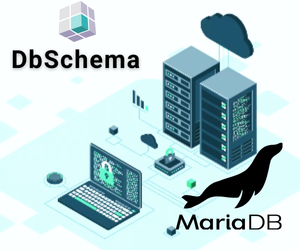DbSchema Blog
Categories
- Cassandra
- Databases
- Dbschema features
- Design
- Firebird
- Mongodb
- Mysql
- Oracle
- Postgresql
- Release notes
- Snowflake
- Sql server
- Sqlite
- Tutorials

Design MariaDB Databases Faster with DbSchema | Visual Modeling & Management Tools
Learn how MariaDB’s speed and efficiency improve database performance and how DbSchema simplifies design, visualization, and management.
Databases • 03-Mar-2025

DbSchema is A Cross-Platform Database Design Tool for Windows, macOS, and Linux
DbSchema is a cross-platform database design tool for Windows, macOS, and Linux. Easily install with native packages and design schemas visually. Download now!
Dbschema features • 26-Feb-2025
MongoDB Database Design - Schema Visualization with Diagrams
Easily visualize and design your MongoDB database with intuitive diagrams. DbSchema helps you explore collections, detect virtual relationships, edit validation rules, and generate interactive documentation for better collaboration.
Mongodb • 21-Feb-2025
Top 5 Database GUI Clients with Git Integration in 2025
Learn how Git integration in database tools helps teams track changes, prevent conflicts, and collaborate efficiently on database projects.
Design • 13-Feb-2025
DbSchema | MySQL - How to Create a Trigger?
Learn how to create triggers in MySQL for logging updates, preventing invalid data, and improving database management with practical examples.
Mysql • 07-Feb-2025

How to Generate Snowflake Database Documentation with DbSchema
Generate and export Snowflake database documentation with DbSchema. Create HTML5 or PDF docs with tables, foreign keys, triggers, and stored procedures.
Snowflake • 05-Feb-2025

Best SQL Editor for Mac/Linux/Windows in 2025 | MySQL, PostgreSQL
Discover how DbSchema's free SQL Editor helps users create tables, view data, and design diagrams with ease. Autocompletion, Java Groovy, Query Results
Dbschema features • 21-Jan-2025

Free Database Diagram Tool - Easy Design and Management
In this article, we’ll show how a database diagram tool simplifies database design and helps teams collaborate more easily.
Dbschema features • 16-Jan-2025

Simplifying Oracle Databases with DbSchema's Unique Features
In this article, we will guide you through connecting DbSchema to your Oracle database and explore the powerful features that simplify Oracle database management.
Oracle • 13-Dec-2024

Top 8 Free Database Design Tools for 2025
In this article, we will highlight 8 of the most popular free tools for database design, focusing on their SQL editing capabilities, visual diagramming features, and overall usability.
Design • 04-Dec-2024